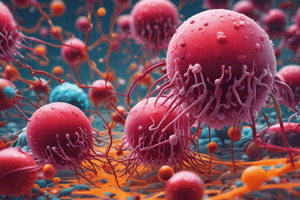Podcast
Questions and Answers
Which pathogen is commonly associated with foodborne illnesses?
Which pathogen is commonly associated with foodborne illnesses?
- Toxoplasma gondii (correct)
- Giardia lamblia
- Trichuris trichiura
- Ascaris lumbricoides
What symptoms are commonly associated with foodborne illnesses?
What symptoms are commonly associated with foodborne illnesses?
- Joint pain and eye redness
- Headache and muscle pain (correct)
- Nosebleeds and fatigue
- Skin rash and coughing
How do foodborne diseases primarily transmit?
How do foodborne diseases primarily transmit?
- Through skin contact
- Through physical touch
- Through ingestion of contaminated food or water (correct)
- Through airborne particles
Which of the following is NOT a common bacterial contaminant associated with foodborne illnesses?
Which of the following is NOT a common bacterial contaminant associated with foodborne illnesses?
At what rate do symptoms of foodborne illnesses typically develop after exposure?
At what rate do symptoms of foodborne illnesses typically develop after exposure?
Which toxin is mentioned as a cause of foodborne diseases?
Which toxin is mentioned as a cause of foodborne diseases?
What is one of the key measures for preventing foodborne illnesses?
What is one of the key measures for preventing foodborne illnesses?
How is the diagnosis of foodborne illnesses typically done?
How is the diagnosis of foodborne illnesses typically done?
What is a common treatment for foodborne illnesses?
What is a common treatment for foodborne illnesses?
What is the primary aim of outbreak investigations related to foodborne illnesses?
What is the primary aim of outbreak investigations related to foodborne illnesses?
Why is understanding foodborne diseases crucial for public health safety?
Why is understanding foodborne diseases crucial for public health safety?
What are some preventive measures mentioned in the text to avoid foodborne illnesses?
What are some preventive measures mentioned in the text to avoid foodborne illnesses?
Study Notes
Foodborne Diseases: Causes, Symptoms, Transmission, Prevention, Treatment, and Control
Foodborne diseases refer to illnesses caused by consuming contaminated food or water. Common pathogens associated with these diseases include bacteria such as Salmonella and Escherichia coli O157, viruses like norovirus, parasites like Toxoplasma gondii, and toxins like botulinum neurotoxin.
Causes of Foodborne Illnesses
The causes of foodborne diseases can vary widely, from bacterial contamination due to poor sanitation practices during food handling to contamination with natural microorganisms present on raw foods like meat or poultry. Some common contaminants include bacteria such as Staphylococcus aureus, Salmonella enterica, Listeria monocytogenes, and E. coli O157; viruses such as norovirus and rotavirus; protozoa such as Giardia lamblia and Cryptosporidium parvum; and helminths such as Trichuris trichiura and Ascaris lumbricoides.
Symptoms of Foodborne Illnesses
Symptoms of foodborne illnesses typically develop within hours to days after exposure. They may include nausea and vomiting, diarrhea, abdominal cramping, fever, dehydration, headache, muscle pain, and joint pain.
Transmission of Foodborne Diseases
Transmission of foodborne diseases occurs primarily through ingestion of contaminated food or water. This can happen directly if an individual consumes contaminated food or indirectly if they consume food prepared by someone who has been infected.
Prevention of Foodborne Illnesses
Preventing foodborne illnesses involves various measures such as proper hygiene during food preparation, safe storage and cooking temperatures, and monitoring for potential contamination sources. This includes washing hands before preparing food, ensuring raw meats don't come into contact with other ready-to-eat foods, and refrigerating leftovers promptly.
Diagnosis and Treatment of Foodborne Illnesses
Diagnosis of foodborne illnesses usually involves identifying the specific pathogen causing the symptoms through laboratory tests of stool samples. Treatment often involves supportive care, such as rehydration and antimotility agents to control diarrhea, although antibiotics may be used in severe cases.
Outbreak Investigation and Control
Outbreak investigations aim to identify the source of contamination and prevent further transmission. This may involve interviewing affected individuals, conducting environmental inspections, and testing food products for bacterial or viral levels.
In conclusion, understanding foodborne diseases is crucial for public health safety. Knowing how these illnesses occur, their symptoms, modes of transmission, prevention strategies, treatments, and control methods can help reduce risk factors and protect communities from potential outbreaks.
Studying That Suits You
Use AI to generate personalized quizzes and flashcards to suit your learning preferences.
Description
Explore causes, symptoms, transmission routes, prevention strategies, and treatments for foodborne illnesses. Learn about common pathogens such as Salmonella, E. coli, norovirus, and more. Understand the importance of outbreak investigations and control measures to safeguard public health.



